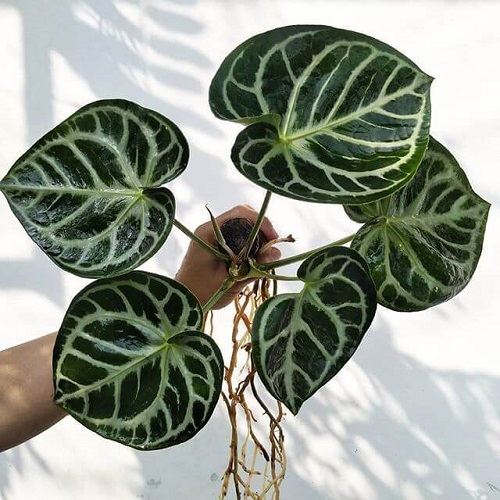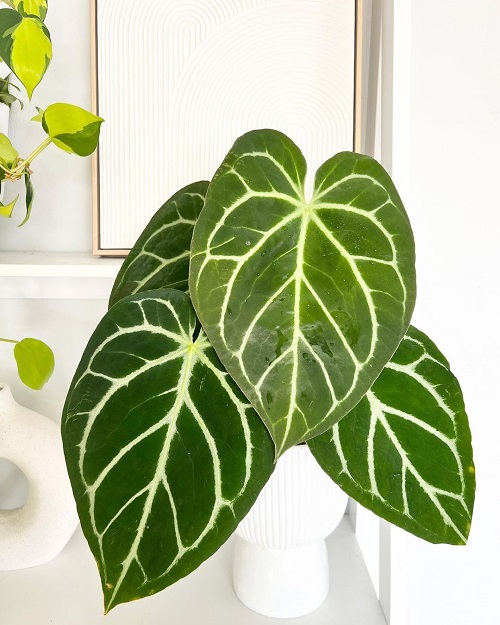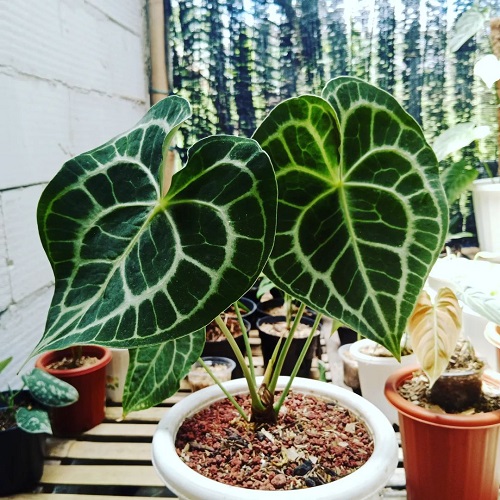Anthurium Crystallinum is one of the most stunning specimens you can have indoors. Our detailed guide will help you grow it easily.

Include this beautiful, charming houseplant with velvety leaves in your indoor plant collection with the help of the Anthurium Crystallinum Care guide discussed below.
Find How to Take Care of Anthurium here
Anthurium Crystallinum Plant Information
Popular as Crystal Laceleaf and Crystal Anthurium, Anthurium Crystallinum is a tropical plant that belongs to the rainforest margins in Central and South America. It shows off large, heart-shaped velvety deep green leaves patterned with silver-white veins; the anterior lobes appear locked together, making it look oval. The undersides have coppery tones.
With appropriate care, Anthurium Crystallinum begins flowering in a year and displays a thin spathe of a dull purple-brown color. It has slow growth, in every 2-5 years, the plant grows approx 20 inches. While growing outdoors, the foliage size is up to 24-30 inches. Anthurium crystallinum grows one new leaf every 4 to 6 weeks and spreads out laterally due to its self-heading growth pattern.
In tropical conditions, the flower occurs all season long and shows off fragrant light green flower spathes with a yellow or red tinge or dull purple.
Fun Fact: This plant not just looks beautiful but also has the ability to purify the air. NASA conducted research in the 1980s to identify plants that effectively eliminate harmful toxins and purify the air. The results showed that Anthurium topped the list, eliminating formaldehyde, ammonia, xylene, and toluene from the surrounding air.
Check out 40 Beautiful Pictures of Anthurium Varieties from Instagram here
Anthurium Crystallinum Varieties

- Anthurium Crystallinum Dark Form: It has deep green leaves.
- Anthurium Crystallinum Silver: This variety has silver glittery veins on velvety foliage.
- Anthurium Crystallinum Black: It boasts dark green velvety leaves.
- Anthurium Crystallinum Hope: This Costa Rican variety was bred from hybrid Anthurium Crystallinum plants in 1995. It displays dark green leaves with more prominent silver veins.
How To Propagate Anthurium Crystallinum

You can propagate Anthurium Crystallinum from seed, cuttings, or division.
- Growing from Seeds: Purchase seeds or gather them from the spadix’s berries and plant them in well-fertilized soil, and they will germinate in 2-5 weeks.
- Growing from Stem Cutting: Use sterile scissors and cut a 5-6 inches long, sturdy stem below the nodes with a few leaves attached to it. Allow the cutting to callus over and plant in well-draining soil, water well, and place the pot in bright, indirect sunlight.
- Growing from Division: Remove the plant from its pot and gently divide it into smaller sections, each with a healthy root system. Cut the subsoil stem of the plantlet into two sections, ensuring each division has attached roots for optimal growth. Allow them to rest for approximately 24 hours before planting each half in separate pots. Maintain soil moisture and feed with a diluted, top-notch fertilizer until the plant becomes established.
Check out 43 Fanciest Anthurium Types You Can Grow here
Requirements for Growing Anthurium Crystallinum

Light
Anthurium crystallinum thrives in bright, indirect light and warm temperatures. The ideal location for growing this plant would be near a window with filtered light or under fluorescent lights.
Avoid exposing the plant to direct, harsh afternoon sunlight, as it can burn velvety leaves.
Soil
Anthurium crystallinum prefers a well-draining potting mix that is rich in organic matter. The ideal soil should include peat moss, perlite, and vermiculite or bark chips.
Good air circulation is also important to prevent root rot, so ensure the pot has adequate drainage holes. Additionally, keep the soil evenly moist but not waterlogged, as excessive moisture can cause root damage. Precisely Anthurium crystallinum thrives well in an equal mixture of:
- Sphagnum moss
- Commercial orchid potting mix,
- Soilless mediums like moss or bark
- Light soil mixes of perlite, coconut coir, pine bark, peat moss, orchid bark, charcoal, and pumice
Water
Maintain soil moisture during the growing season. This implies watering the plant regularly, especially in the summer. The soil should never be allowed to dry out completely. If you live in a humid climate, Anthurium crystallinum can survive without water for up to two weeks.
However, in the winter months, it’s essential to keep a close eye on the soil’s moisture levels and adjust watering frequency accordingly to ensure Anthurium crystallinum remains healthy and vibrant.
Temperature and Humidity
Anthurium crystallinum grows best in above-average humid conditions. It requires a minimum temperature of 65°F to thrive. The perfect temperature for this plant is between 75°F and 80°F.
If you live in a cooler climate, it is recommended to keep your Anthurium crystallinum outside on your patio during the summer and in a greenhouse during the winter.
Find out How to Force Anthuriums to Bloom Faster here
Anthurium Crystallinum Care

Pruning
Anthurium crystallinum requires minimal maintenance and grooming. Occasionally prune the plant from the top by removing any dead or yellowed leaves, as well as any inflorescences.
Fertilizer
Anthurium crystallinum benefits from a slow-release or balanced organic, water-soluble NPK fertilizer. A 20-20-20 or 30-10-10 fertilizer applied at half strength every 2-4 weeks during the growing season (spring to fall) will provide the necessary nutrients.
Avoid feeding during the winter months, when the plant is dormant. It’s also important to follow the manufacturer’s instructions for dilution and application rates.
Pro Tip: You can also apply well-diluted fish emulsion once a month.
Note: Do not use chemical fertilizers, as they might ruin the plant’s roots.
Re-Potting
Re-pot Every Anthurium crystallinum once in two years during spring in a new terra cotta pot filled with a fresh potting mix containing organic matter. Only repot if the plant’s roots have outgrown the pot and are crowded in the soil.
Pests and Diseases
Anthuriums can be attacked by pests such as mealybugs, aphids, and scales. To repel these pests spray the plant with insecticidal soap or create a neem oil solution by mixing two tablespoons of neem oil, three teaspoons of mild liquid soap, and a gallon of water. Apply the solution once a week for 2 to 3 weeks until all pests disappear.
Regarding diseases, bacterial and fungal infections can be an issue with Anthurium crystallinum. If you notice the plant has brown or yellowed lesions along the edges of its leaves, this is often a sign of overwatering. To prevent the spread of infection, cut off the affected leaves with sterile scissors.
Root rot is another common problem that can be caused by overwatering or if the plant is sitting in water. If Anthurium crystallinum suddenly begins to yellow and wilt, check its roots. Pythium fungal infection, which is caused by waterlogged soil, can lead to yellowing and wilting of the leaves.
Have a look at the Anthurium Besseae Quick Care Guide here
Anthurium Crystallinum Toxicity
The sap of Anthurium Crystallinum contains insoluble oxalic crystals that can cause harmful reactions if ingested. Both humans and pets may experience allergic reactions, breathing difficulties, and oral and intestinal irritation if exposed to the sap, according to the ASPCA and Pet Poison Helpline.
Conclusion
Anthurium Crystallinum can be a stunning addition to any indoor garden. By providing it with the right growing conditions, including bright indirect light, high humidity, and a warm temperature, you can ensure that your plant thrives.
With proper care, this beautiful houseplant can bring a touch of tropical elegance to your home for years to come.

